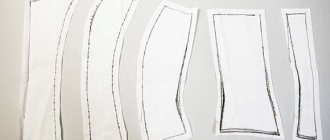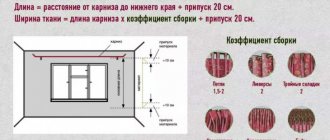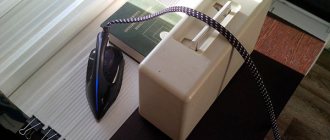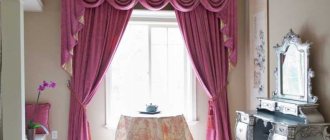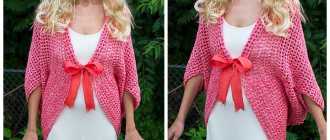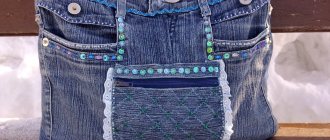The interior of an apartment is a complete organism in which every element plays an important role. The window, the appearance is not in the last place here; the decor includes fabric and various variations. Beautiful curtains, unlike blinds, add a cozy atmosphere to the room and make the apartment warm.
Beautiful curtains in the interior
It is better to decorate windows with classic decor, using curtains with drapery - then they will be lush and recognizable. Bow folds on curtains can be made in different styles and types. Just always take into account that the presence of tape implies the possibility of the curtain tearing under strong tension, because at the seam the fabric becomes somewhat thinner.
When they want to make a curtain themselves, the first thing they do is buy even scraps of fabric. This does not mean at all that you can’t make beautiful folds on the curtains yourself. This is not such a difficult task that you should outsource the work to a professional and pay a lot of money for it. The advantage of working independently is that you can always correct the points you don’t like, try them on the window and see what the result is. Today we will figure out how to make folds on curtains ourselves, what is required for this, and so on.
Types of folds
There are not many drapery options; you can create 3 types manually:
- one-sided: when they are performed, the fabric is distributed in the form of even flounces;
- bow: are a type of one-sided, located in different directions;
- counter: they have folds of fabric directed towards each other.
When decorating an interior, different types of folds are often used on curtains at the same time. Blinds and curtains compete with dense fabrics.
Radiation
To create this type of fold, you need a braid. The design of the curtains in this case requires the presence of a lining, or you will have to choose a heavy fabric to sew them. Its size with this method of assembling folds is large. The material required is 2 times the width of the finished curtain.
Glasses
This type of fold is created by gathering the fabric from the bottom and inserting filling at the top to create a structure that is shaped like a glass. It is recommended to make such tucks on plain fabrics that can be draped. When creating side folds, the fixation is first done manually and only then sewn on a machine.
Cylindrical
This type of curtain design is considered universal, because... suitable for any type of fabric. When purchasing material, you need to take into account that the canvas should be 2.5 times wider than the length of the cornice. The size of the braid is matched to the material itself.
Buffs
Puffs have different designs, which depend on the imagination of the tailor. Most often, many grips are made on the material, combined into groups.
Tubes
This type of drapery is created by using a long braid and creating a more rounded fold shape.
French
This type of fold is also called French drapery; it is created by using a special cord that is pulled through inserts.
Fan
Fan ones are similar to counter ones, with the difference that in this case there is an additional detail - the bottom. A similar drapery is performed on the wrong side of the curtains, and when purchasing material, you should take into account the cost of allowances for the fold. The width of such allowances is equal to half the depth of the fold size.
Chicken feet
This drapery has an original appearance - it has a main lower point, from which a whole group of folds diverges.
Unilateral
Calculating the amount of fabric needed to create one-sided tucks is the simplest. In this case, the length of the cornice, the coefficient and the size of the allowances for the side seams are taken into account.
Bow
They can most often be found when decorating curtains. It is not difficult to perform such drapery.
An important point in their manufacture is the accurate calculation of folds, which can be located across the entire width of the curtains or alternate with even sections of material.
The minimum bending value when performing them is only 2 cm, the maximum is 16 cm.
There are several ways to create folds, and they differ in the ratio:
- 1:3. In this case, there are completely no gaps between the edges of the bow folds. It turns out that they are in contact with each other. The consumption of material is quite large; it will be required 3 times more than the width of the window opening.
- 1:2.5. In this case, there is a gap between the edges of the bow folds, but it is less than the length of the fold itself. The fabric consumption in this case is slightly less than in the first case, only 2.5 times the width of the cornice.
- 1:2. With this ratio, the distance between the edges of the bow fold is equal to the fold itself. In this case, the canvas required is 2 times the size of the window opening.
Counter
This type of drapery is obtained by folding the fabric on both sides.
We sew curtains ourselves
You can make cylindrical folds on curtains yourself, the main thing is to buy braid and prepare thoroughly. If the operation is carried out exclusively by hand, then you will simply have to pull the strings sewn into the tape, but they quickly wear out and require replacement. And if the lace breaks somewhere in the middle, then you will have to completely rip out the top of the curtain.
Step by step instructions
First you need to calculate the folds for cascading Roman blinds. In addition, here you will need to calculate the dimensions from ceiling to floor, the width of the cornice. You also need to take into account the number of windows on which there will be curtains with drapery. If the fold depth is required within 15 cm, then initially you need to sew at least 10 cm with tape. When making initial calculations, you should add an extra 3-5 centimeters so as not to make mistakes with the fabric, otherwise there may not be enough for full folds.
After the fabric is ready, you should move on to creating high-quality drapery. To do this, a ribbon is sewn on, this is how a manual fold is made on the curtains. Before this, you need to remove protruding threads and laces; there is a special technology, but this is done by hand. Of course, if you have the skills to use a sewing machine and the seams come out smooth, then you can seriously make your work easier.
What you need to do the work
Regardless of what kind of drapery and type is required, certain tools and devices are always required:
Curtain fabric
- Curtain fabric;
- Tape, taking into account the type and quality of the material;
- Needles;
- Threads;
- Sewing machine.
When you first come to the store, taking into account the fact that you are planning to make folds on tulle curtains, immediately take fabric with a reserve. In order for the view to be beautiful and the curtains to cover the window, the calculation must be done as follows: multiply the desired number of folds by the depth. The resulting number should be added to the width of the curtain, which should cover the window as it is already completed. Well, plus small side hems, they require 2.5 cm on each side. The length from the bottom to the cornice does not change at all, here you only need to make an adjustment for the upper and lower processing.
Before beautifully laying folds on the curtains, smooth fabric, canvas, should be well processed.
The threads should be removed, the lacing should be tied, and the edges should be processed and stitched. This is best done on a sewing machine; doing it by hand will take too much time. Before stitching, it is advisable to practice on a scrap of fabric that you don’t mind.
Most of those who design curtains professionally do it by hand. When the fabric is sewn independently, the stitching of the fabric is tighter and the destruction of such an assembly is less likely. In this case, the labor intensity increases significantly, but this pays off due to the growing reliability of the fabric - if you pull a hanging curtain that is sewn on a machine, the colloquial line will remain on the cornice, and the curtain will remain in your hand.
We sew wide curtain tape
Before you make a French fold on the curtains, you need to tidy up the line on top of which the braid will be sewn. This needs to be done at the hem, you can go in two ways:
- When sewing the edges into the hem, it is worth folding the edge of the fabric tightly and ironing it. This will make it easier to smooth out the folds on the curtain and stitch. After this, the braid should lie on top of the hem, at a distance of a centimeter from the edge. In order not to lose the measured distance, you can attach the fabric with paper clips. The ribbon needs to be pulled out along the edges, tied and the excess cut off. The hem allowance after completing the manipulations should be one and a half centimeters. To securely secure the edges and correctly make folds on the curtains, you need to stitch the braid along the perimeter;
- In another case, you need to assemble curtains of a color different from the main fabric. First, the main fabric is folded, and the braid is cut out on top. In this case, both front sides of the canvas and braid should be facing each other. The lines must be laid at a distance of at least 1 cm from the hem, and it is advisable to iron the tape to make it easier to stitch. You can also bend the edging to the reverse side, there it is attached in the same way, there is no difference. In some cases, the braid is also attached on both sides at once, after which the resulting product is swept away. But at the same time, it is important to clearly calculate the folds on the lambrequin and not make a mistake, otherwise it will turn out that the window will not close completely. The edges need to be processed in the same way as in the previous version.
httpv://youtu.be/fljVw-pUWA4
After you have sewn the edging on the curtain, it is better to hang it on the curtain rod. It is unlikely that you can select the width of curtains with folds on the floor; it is better to immediately climb on and hang them, and then adjust them as you want.
Methods for folding folds
Before calculating the amount of fabric needed to sew curtains, you need:
- Take an accurate measurement of the length of the cornice.
- Determine how the side edges will be processed.
- Calculate the depth of the folds taking into account the type of fabric chosen.
Manually
The fabric of the future curtain can be draped manually. In this case, it is necessary to carefully calculate the fabric consumption and the required tape footage for forming tucks.
There are difficulties with this sewing method. All the ropes have to be pulled by hand. In this case, they wear out much faster. If they tear, the entire drapery will have to be restored at once.
Using tape attached to the top of the fabric
Most often, simple folds are created using braid. In this case, it is necessary to take into account the allowance for the tape. More complex designs may require 3 to 4 rows of tape.
The most convenient options for tapes are adhesive ones.
They do not require sewing, but are connected to the fabric when ironed.
How to hang curtains on different fasteners?
When ordering curtains, you can immediately provide curtain tape. It will make the process of hanging curtains easier. The first step is to tighten all the threads, there can be from 2 to 5 pieces. Then tie knots on both sides of the product so that the braid does not unravel. The tighter you pull the thread, the more frequent folds you will get. After this you can hook the hooks. The optimal distance between them is 10 cm. A special braid is provided for attaching the hooks. Now the curtains are ready, you can hang them on the cornice. This method is suitable for creating smooth and soft waves.
If you decide to use loops or grommets, the process will go much faster. Take a round pipe and pass all the fasteners through it. Then return the bar to its place and straighten the curtains, forming folds.
Application in the interior of premises
Curtains with drapery of various types are used to decorate a variety of rooms. The choice of fold type depends on the type of fabric chosen and its density.
Kitchen
In the kitchen it is common to use less dense curtains. Preference is given to thin, easily draped fabrics.
Living room
Living rooms are a special category of premises. In such places it is customary to place curtains with lambrequins. It is popular to use different types of tucks to decorate the same fabric, with tassels and fringes as additional decoration.
Bedroom
In this case, dense materials are used that can create the necessary twilight in the room to ensure a restful sleep. When decorating a room, curtains should be in harmony with the surrounding interior.
Children's
To decorate children's rooms, window curtains with bright patterns are often chosen. When draping such fabrics, the location of the pattern should be taken into account. You cannot choose massive, heavy types of folds.
How to create bow folds?
In bow versions, the fold lines are located at the back. The central part (bow) is located on the face of the curtain, and the folds are connected on the wrong side.
When marking bow folds, it is important to always start with a value of c. In the future, this distance is not laid down, but is wrapped on the opposite side. Next, you should make the markings according to the calculation (for continuous ones, 10 cm, for the option with intervals, 7.5 cm each). For greater convenience in the latter case, it is better to mark the gaps with colored chalk or a felt-tip pen.
After applying the markings, you can begin decorating. For solid model:
- lay the first bow - move the fabric at the level of the first mark to the beginning of the fabric, and align mark 2 with 3 and pin it. In this case, the fold lines should meet in the center of the bow. After this, the extreme bend can be released;
- second bow - combine mark 4 with 3, and 6 with 5. Pin both folds;
- continue until the end of the fabric;
- stitch and finish the top.
For the spaced option, the first bow is formed as described above. For the second bow: combine mark 5 with 4, and pull 7 to 6. Pin and similarly form the remaining bows and process the top of the curtain.
Manual assembly method
Many people believe that only professionals can lay drapery by hand. However, it is not. This method of design is more reliable and durable, since the strings of the curtain tape can break. This method will require you to spend more time, but the results are worth it.
Before starting work, you need to calculate how much fabric you will need to decorate with drapery. Be sure to measure the length of the curtain rod with utmost care. This value also determines the length of the curtains. The resulting value must be divided by the number of folds that you plan to lay. As a result, you will get the distance between them. It is not recommended to take it larger than 10-14 cm. The optimal assembly depth is 14-20 cm.
The selected depth must be multiplied by their number, add to the result the length of the cornice and 2-4 cm of reserve, which will be used to process the curtains on the sides. If a curtain tape is sewn onto the curtain, and you assemble it manually, then the strings from the tape need to be removed, since in this case they will only get in the way.
When the material is prepared, you need to hem it at the folds in the upper part of the fabric. This can be done manually with a needle and thread or using a machine. Select threads so that they are not visible on the fabric. Additionally, the curtains can be decorated with buttons in matching or contrasting colors, depending on your idea.
Thus, you can now assemble the curtains yourself in a way that seems more convenient and practical to you. In any case, the work must be done carefully so as not to damage the canvas. Before performing it, pay attention to calculating the required amount of fabric. Drapery curtains will look appropriate in any interior; you can independently determine its thickness depending on your preferences and the overall interior of the room.
Source
Conclusion
DIY assemblies can be done using curtain tape or by hand. The first method is simple and does not require much effort. The second is more labor-intensive, but you can create beautiful, stylish folds.
Typically, curtains have one-sided, counter or bow options with or without gaps. The calculation and sequence of actions to create the necessary composition depends on this.
Source

